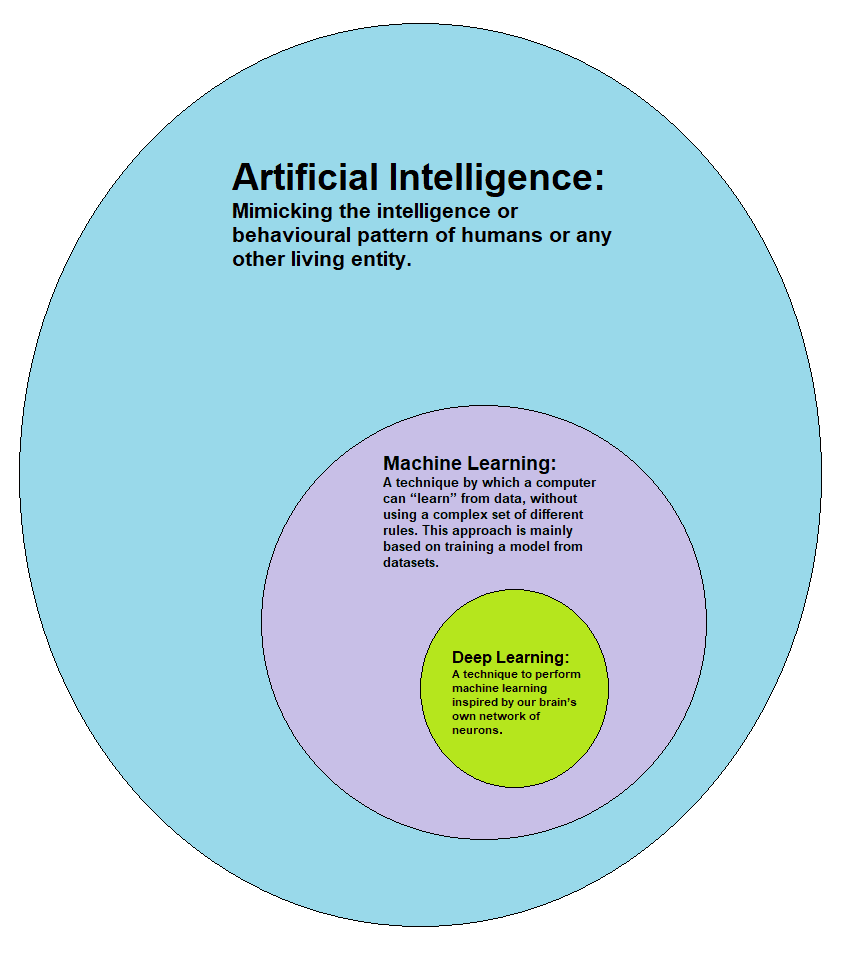“Deep learning has become increasingly popular in recent years, but when is it the right approach to solving problems? Understanding the benefits and limitations of deep learning can help determine if it’s the best solution for your specific needs.”
Understanding Deep Learning: How It Differs from Other Machine Learning Techniques
Introduction
As an AI expert working at Prometheuz, I often get asked about the differences between deep learning and other machine learning techniques. While both are used to train models that can make predictions or decisions based on data, deep learning is a subset of machine learning that uses artificial neural networks to process and learn from large amounts of data.
How Deep Learning Works
Deep learning algorithms use multiple layers of interconnected nodes to process data inputs and generate outputs. Each layer extracts different features from the input data, allowing for increasingly complex representations as the signal propagates through the network. This allows deep learning models to learn more abstract and nuanced patterns than traditional machine learning techniques, which typically rely on hand-engineered feature extraction.
Advantages of Deep Learning
– Can learn from unstructured or raw data, such as images or audio
– Can handle large datasets with many variables
– Can automatically extract relevant features without human intervention
– Can improve performance with additional training data
Disadvantages of Deep Learning
– Requires large amounts of labeled training data
– Can be computationally expensive and time-consuming to train
– May overfit to training data if not regularized properly
– Can be difficult to interpret or explain how the model arrived at its decision
Overall, understanding the differences between deep learning and other machine learning techniques is important for choosing the right approach for a given problem. While deep learning has shown impressive results in fields like image recognition and natural language processing, it may not always be the best choice depending on the available data and resources.
Improving Image Recognition and Classification with Deep Learning
What is Deep Learning in Image Recognition?
Deep learning algorithms have revolutionized the field of image recognition by enabling computers to learn features and patterns from large datasets without being explicitly programmed. These algorithms use a layered neural network architecture that mimics the way the human brain processes information. The first layer of the network learns simple features, such as edges and corners, while subsequent layers learn more complex features, such as shapes and objects. The final layer produces a prediction or classification based on the learned features.
Applications of Deep Learning in Image Recognition
Deep learning has been applied to various image recognition tasks, including object detection, face recognition, and medical imaging. In object detection, deep learning models can accurately detect and classify objects within an image, which has applications in self-driving cars and surveillance systems. In face recognition, deep learning models can recognize individuals even when they are wearing glasses or hats. In medical imaging, deep learning models can assist clinicians in diagnosing diseases such as cancer by analyzing images from MRI scans.
Benefits of Using Deep Learning in Image Recognition
Compared to traditional machine learning methods for image recognition, deep learning offers several benefits. Firstly, deep learning models can achieve higher accuracy rates due to their ability to learn complex features from large datasets. Secondly, deep learning models are more flexible and adaptable to new data because they do not rely on pre-defined feature extraction techniques. Finally, with advances in hardware technology such as graphics processing units (GPUs), training deep learning models has become faster and more efficient.
The Benefits of Using Deep Learning in Natural Language Processing Tasks
What is Natural Language Processing?
Natural language processing (NLP) is a subfield of artificial intelligence that focuses on enabling computers to understand human language. NLP has applications in various tasks such as sentiment analysis, machine translation, and chatbots. Traditional NLP methods involve manually defining rules and patterns for the computer to follow, but deep learning algorithms have enabled computers to learn these patterns from large datasets.
Applications of Deep Learning in NLP
Deep learning has been applied to various NLP tasks, including language modeling, named entity recognition, and sentiment analysis. In language modeling, deep learning models can predict the next word in a sentence based on the context of previous words. In named entity recognition, deep learning models can identify and classify entities such as people, organizations, and locations within a text. In sentiment analysis, deep learning models can determine the emotional tone of a text and classify it as positive or negative.
Benefits of Using Deep Learning in NLP
Compared to traditional rule-based methods for NLP, deep learning offers several benefits. Firstly, deep learning models can achieve higher accuracy rates due to their ability to learn complex patterns from large datasets. Secondly, deep learning models are more flexible and adaptable to new data because they do not rely on pre-defined rules or patterns. Finally, with advances in hardware technology such as graphics processing units (GPUs), training deep learning models has become faster and more efficient.
Analyzing Large Datasets and Extracting Insights with Deep Learning
What is Big Data?
Big data refers to the massive amounts of structured and unstructured data that are generated by businesses and individuals every day. Traditional methods for analyzing this data are often time-consuming and require significant manual effort. However, with advancements in deep learning algorithms, it is now possible to extract insights from big data more efficiently.
Applications of Deep Learning in Big Data Analytics
Deep learning has been applied to various big data analytics tasks such as image and video analysis, fraud detection, and customer segmentation. In image and video analysis, deep learning models can analyze large amounts of visual data to identify patterns and features. In fraud detection, deep learning models can detect anomalies in transactional data that may indicate fraudulent activity. In customer segmentation, deep learning models can group customers based on their preferences and behaviors to inform marketing strategies.
Benefits of Using Deep Learning in Big Data Analytics
Compared to traditional methods for big data analytics, deep learning offers several benefits. Firstly, deep learning models can handle large amounts of structured and unstructured data more efficiently than traditional methods. Secondly, deep learning models can learn complex patterns from the data without requiring manual feature engineering. Finally, with advances in hardware technology such as graphics processing units (GPUs), training deep learning models has become faster and more efficient.
When to Use Deep Learning for Predictive Modeling
What is Predictive Modeling?
Predictive modeling is a process that involves using historical data to make predictions about future outcomes. Traditional methods for predictive modeling involve manually selecting features or variables that are believed to be relevant to the outcome being predicted. However, with advancements in deep learning algorithms, it is now possible to automatically learn these features from the data.
Applications of Deep Learning in Predictive Modeling
Deep learning has been applied to various predictive modeling tasks such as stock price prediction, weather forecasting, and disease diagnosis. In stock price prediction, deep learning models can analyze historical market data to predict future trends. In weather forecasting, deep learning models can analyze historical weather patterns to predict future conditions. In disease diagnosis, deep learning models can analyze medical images or patient records to assist clinicians in making accurate diagnoses.
Benefits of Using Deep Learning in Predictive Modeling
Compared to traditional methods for predictive modeling, deep learning offers several benefits. Firstly, deep learning models can handle large amounts of data and learn complex patterns without requiring manual feature engineering. Secondly, deep learning models can achieve higher accuracy rates than traditional methods due to their ability to learn from the data. Finally, with advances in hardware technology such as graphics processing units (GPUs), training deep learning models has become faster and more efficient.
Challenges Associated with Implementing Deep Learning Algorithms
Data Availability and Quality
One of the biggest challenges associated with implementing deep learning algorithms is ensuring that there is enough high-quality data available for training the model. Deep learning algorithms require large amounts of data to learn complex patterns, but not all datasets are suitable for use in a deep learning model. Additionally, the quality of the data can also impact the accuracy and effectiveness of the model.
Hardware and Software Requirements
Another challenge associated with implementing deep learning algorithms is ensuring that there is adequate hardware and software infrastructure available to support training and deploying the model. Deep learning models require powerful hardware such as graphics processing units (GPUs) for efficient training, which can be costly. Additionally, deploying a trained model requires specialized software frameworks such as TensorFlow or PyTorch.
Interpretability and Explainability
A third challenge associated with implementing deep learning algorithms is ensuring that the model’s predictions are interpretable and explainable. Deep learning models are often seen as “black boxes” because it can be difficult to understand how they arrived at a particular prediction or classification. This lack of interpretability can make it difficult to trust or use the model in certain applications.
Why Businesses Should Consider Investing in the Development of a Deep Learning Model
Improved Decision Making
Investing in the development of a deep learning model can provide businesses with valuable insights and predictions that can inform decision making. For example, a deep learning model could be used to predict which products are likely to sell well in the future, allowing businesses to make informed decisions about inventory and marketing.
Increased Efficiency
Implementing a deep learning model can also increase efficiency by automating tasks that would otherwise require significant manual effort. For example, a deep learning model could be used to automatically classify customer inquiries and route them to the appropriate department or agent.
Competitive Advantage
Finally, investing in the development of a deep learning model can provide businesses with a competitive advantage over their competitors. Deep learning models can provide insights and predictions that may not be available to competitors who are using traditional methods for data analysis and prediction.
Data Types Best Suited for Training a Deep Learning Model
Structured Data
Structured data refers to data that is organized into predefined categories such as tables or spreadsheets. Structured data is well-suited for training deep learning models because it can be easily fed into the model without requiring additional preprocessing steps. Examples of structured data include financial records, customer demographics, and inventory levels.
Unstructured Data
Unstructured data refers to data that does not have predefined categories or structures. Unstructured data is more challenging to work with than structured data because it requires additional preprocessing steps such as text normalization or feature extraction. However, unstructured data can also be valuable for training deep learning models because it often contains rich information that may not be captured by structured data alone. Examples of unstructured data include social media posts, images, and audio recordings.
The Effectiveness of a Hybrid Approach Combining Traditional Machine Learning and Deep Learning Techniques
What is a Hybrid Approach?
A hybrid approach involves combining traditional machine learning techniques with deep learning techniques to achieve better results than either method alone. Traditional machine learning methods often involve manually selecting features or variables that are believed to be relevant to the outcome being predicted, while deep learning algorithms can automatically learn these features from the data.
Applications of a Hybrid Approach
A hybrid approach has been applied to various tasks such as fraud detection, stock price prediction, and image recognition. In fraud detection, a hybrid approach can combine traditional rule-based methods with deep learning models to detect anomalies in transactional data. In stock price prediction, a hybrid approach can combine traditional time series analysis with deep learning models to predict future trends. In image recognition, a hybrid approach can combine traditional feature extraction techniques with deep learning models to improve accuracy rates.
Benefits of a Hybrid Approach
Compared to using either traditional machine learning or deep learning techniques alone, a hybrid approach offers several benefits. Firstly, a hybrid approach can leverage the strengths of both methods to achieve higher accuracy rates and better performance. Secondly, a hybrid approach can provide more interpretable and explainable results than using deep learning alone. Finally, by combining multiple methods, a hybrid approach can be more robust and resilient to changes in the data or environment.
Preparing Data for Use in a Deep Learning Model: Best Practices and Pitfalls to Avoid
Data Cleaning and Preprocessing
One of the most important steps in preparing data for use in a deep learning model is cleaning and preprocessing the data. This involves removing any irrelevant or redundant features, handling missing values or outliers, and normalizing the data so that it is consistent across all features.
Training-Validation-Testing Split
Another important step in preparing data for use in a deep learning model is splitting the data into training, validation, and testing sets. The training set is used to train the model, the validation set is used to tune hyperparameters and prevent overfitting, and the testing set is used to evaluate the final performance of the model.
Overfitting and Underfitting
One common pitfall to avoid when preparing data for use in a deep learning model is overfitting or underfitting. Overfitting occurs when the model becomes too complex and starts fitting noise in the data rather than true patterns. Underfitting occurs when the model is too simple and fails to capture important patterns in the data. To avoid these pitfalls, it is important to monitor the model’s performance on both the training and validation sets and adjust hyperparameters as necessary.
Data Augmentation
Finally, another best practice for preparing data for use in a deep learning model is data augmentation. Data augmentation involves generating additional training examples by applying random transformations such as rotations or scaling to existing examples. This can help prevent overfitting by increasing the diversity of examples available for training.
Data Types Best Suited for Training a Deep Learning Model
Deep learning models are best suited for handling complex data types such as images, audio, and text. These data types have high dimensionality and require extensive feature engineering to extract meaningful information. Convolutional neural networks (CNNs) are commonly used in image processing tasks, while recurrent neural networks (RNNs) are effective in natural language processing (NLP) tasks.
CNNs for Image Processing
CNNs consist of several layers that perform convolution and pooling operations on the input image. The convolutional layer applies a set of filters to the input image to extract features such as edges, corners, and textures. The pooling layer reduces the dimensionality of the output from the convolutional layer by performing operations such as max-pooling or average-pooling.
Example: Image Classification
An example of using CNNs is image classification, where the model learns to classify images into different categories based on their features. The model is trained on a dataset of labeled images, where each image is assigned a label indicating its category. During training, the model adjusts its weights to minimize the error between its predicted labels and the true labels.
The Effectiveness of a Hybrid Approach Combining Traditional Machine Learning and Deep Learning Techniques
A hybrid approach that combines traditional machine learning (ML) techniques with deep learning (DL) can be more effective than using either technique alone. Traditional ML algorithms such as linear regression, decision trees, and support vector machines can be used for preprocessing data before feeding it into a DL model or for post-processing its outputs.
Preprocessing with Traditional ML Algorithms
Traditional ML algorithms can be used for feature extraction, dimensionality reduction, and data cleaning. For example, principal component analysis (PCA) can be used to reduce the dimensionality of high-dimensional data such as images or audio. Another example is using decision trees to select the most informative features for a DL model.
Example: Using PCA for Face Recognition
An example of using traditional ML algorithms is face recognition, where PCA is used to extract the most important features from an image before feeding it into a DL model. The DL model then learns to recognize faces based on these features.
Preparing Data for Use in a Deep Learning Model: Best Practices and Pitfalls to Avoid
Data preparation is a crucial step in building an effective DL model. Poorly prepared data can lead to inaccurate predictions and wasted resources. Some best practices for preparing data include cleaning, preprocessing, and augmenting the data.
Cleaning Data
Cleaning data involves removing or correcting errors, missing values, outliers, and duplicates in the dataset. This step ensures that the dataset is consistent and accurate.
Example: Removing Outliers
An example of cleaning data is removing outliers from a dataset of house prices. Outliers are values that are significantly different from other values in the dataset and can distort the model’s predictions. By removing them, we ensure that our model is trained on representative data.
Preprocessing Data
Preprocessing data involves transforming it into a format suitable for feeding into a DL model. This includes scaling, normalizing, encoding categorical variables, and reducing dimensionality.
Example: Scaling Data
An example of preprocessing data is scaling numerical features such as age or income to have similar ranges. This ensures that no one feature dominates others during training.
Benefits of Regular Exercise
Regular exercise provides numerous benefits for both physical and mental health. One major benefit is improved cardiovascular health. Engaging in regular physical activity can help reduce the risk of developing heart disease, stroke, and high blood pressure by strengthening the heart and improving circulation.
Another benefit of regular exercise is weight management. Physical activity helps burn calories and build muscle, which can lead to weight loss or maintenance. This can also improve overall body composition and reduce the risk of obesity-related diseases such as diabetes.
In addition to physical health benefits, regular exercise has a positive impact on mental health. Exercise has been shown to reduce symptoms of anxiety and depression by releasing endorphins, which are natural mood boosters. It can also improve cognitive function and memory retention.
Types of Exercises
There are many different types of exercises that individuals can incorporate into their fitness routine. Aerobic exercises such as running, cycling, or swimming are great for improving cardiovascular health and burning calories. Strength training exercises such as weightlifting or resistance band workouts help build muscle mass and improve body composition.
Flexibility exercises such as yoga or stretching can help improve range of motion and prevent injury. High-intensity interval training (HIIT) combines cardio and strength training for a full-body workout in a shorter amount of time.
It’s important to find an exercise routine that works for your individual needs and preferences. Mixing up different types of exercises can also prevent boredom and keep your fitness routine interesting.
Tips for Staying Motivated
Staying motivated to regularly exercise can be challenging, but there are ways to make it easier. Setting achievable goals can help provide motivation to stay on track with your fitness routine. Whether it’s running a 5k or being able to lift a certain amount of weight, having specific goals in mind can give you something tangible to work towards.
Finding a workout buddy or joining a fitness community can also provide accountability and social support. Having someone to exercise with can make it more enjoyable and help you stay on track.
Finally, it’s important to listen to your body and take rest days when needed. Overexerting yourself can lead to injury and burnout, so it’s important to find a balance between pushing yourself and allowing for proper recovery time.
Benefits of Regular Exercise
Regular exercise has numerous benefits for both physical and mental health. Firstly, it helps to maintain a healthy weight by burning calories and increasing metabolism. It also helps to build muscle mass, which in turn supports good posture and balance. Additionally, regular exercise can improve cardiovascular health by reducing the risk of heart disease, stroke and high blood pressure.
Moreover, exercise is known to boost mood and reduce stress levels. This is because physical activity releases endorphins – the body’s natural feel-good chemicals – which can help to alleviate symptoms of depression and anxiety. Furthermore, participating in group sports or fitness classes can provide an opportunity to socialize and connect with others who share similar interests.
Overall, incorporating regular exercise into your lifestyle can have significant positive effects on both physical and mental wellbeing.
The Importance of Cardiovascular Exercise
Cardiovascular exercise refers to any activity that raises the heart rate for an extended period of time. This type of exercise is particularly important for maintaining good cardiovascular health as it strengthens the heart muscle and improves circulation throughout the body.
Examples of cardiovascular exercises include running, cycling, swimming and dancing. These activities are known to increase endurance levels over time, allowing individuals to perform physical tasks with greater ease.
Benefits of Yoga
Yoga is a form of exercise that focuses on flexibility, balance and mindfulness. Practicing yoga regularly has been shown to have numerous benefits for both physical and mental health.
For example, yoga can help to improve flexibility by stretching muscles and joints throughout the body. It also promotes relaxation through controlled breathing techniques which can help reduce stress levels.
In addition, practicing yoga has been linked to improved sleep quality as well as reduced symptoms of anxiety and depression. Furthermore, certain types of yoga such as hot yoga or power yoga can be more physically demanding than others, providing a challenging workout for those seeking a more intense form of exercise.
Overall, incorporating yoga into your fitness routine can provide a range of physical and mental health benefits.
In conclusion, deep learning is a powerful tool that can be used to solve complex problems in various fields such as healthcare, finance, and transportation. It’s best suited for tasks that require pattern recognition and decision-making capabilities. If you’re unsure whether deep learning is the right solution for your project, feel free to get in touch with us. We offer a range of AI services that can help you achieve your goals. Let’s explore the possibilities together!

Where do we use deep learning?
Deep learning technology is utilized in many image recognition, natural language processing, and speech recognition tools. These applications are becoming more widespread, ranging from self-driving vehicles to language translation services.
When should you avoid deep learning?
If you need to describe the inner workings of an algorithm to stakeholders, even a simplified explanation may be difficult for them to comprehend. This can be a challenge when presenting the algorithm to others.

What is the need of deep learning?
Deep learning technology doesn’t require as much data pre-processing as traditional machine learning. These algorithms can analyze unstructured data, such as text and images, and automatically extract important features, reducing the need for human intervention.
When should we not use autoencoders?
There are cases where it may not be appropriate to use autoencoders. One potential problem is that they may not correctly identify input errors that differ from those in the training data or changes in relationships that a human would easily notice. Additionally, there is a risk of losing important information from the input data. It is important to carefully consider these drawbacks before using autoencoders.
When would you use ML vs deep learning?
Machine learning refers to a type of data analysis that can operate using smaller data sets and requires some human intervention to adjust and improve. In contrast, deep learning involves using large amounts of data to teach the computing system to learn and make decisions on its own, based on past experiences. Although deep learning takes longer to train, it generally results in higher accuracy compared to machine learning.
Why do we use deep learning over machine learning?
Machine learning uses less computing power, while deep learning requires less ongoing human involvement. Deep learning is capable of analyzing unstructured data, images, and videos in ways that machine learning cannot. In every industry, there will be opportunities for careers that involve both machine and deep learning.









